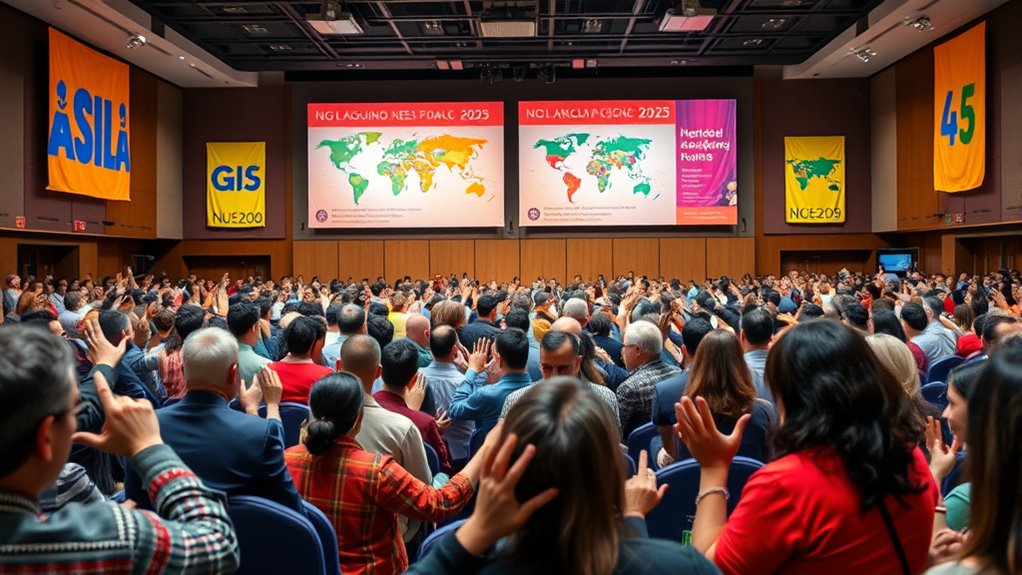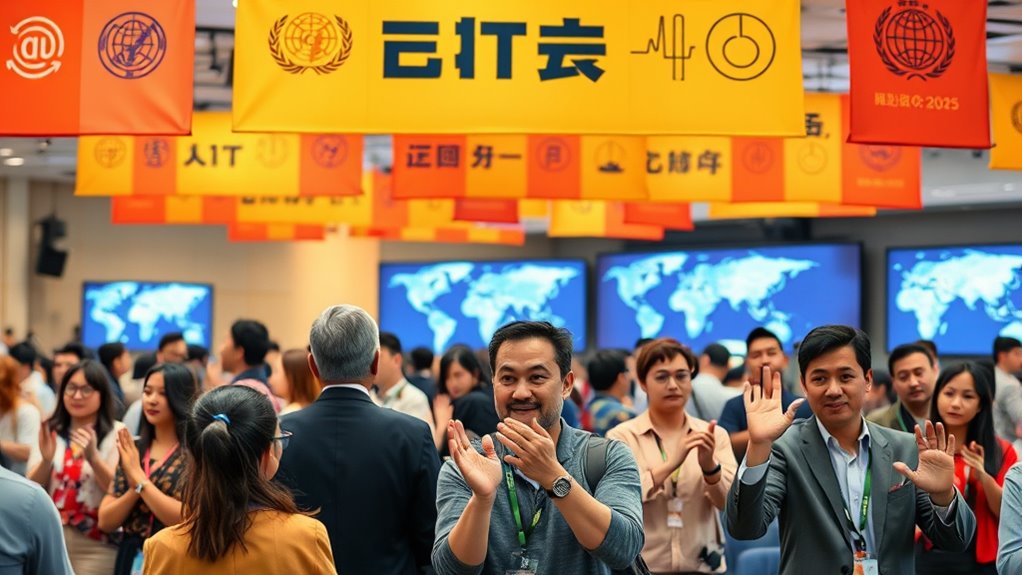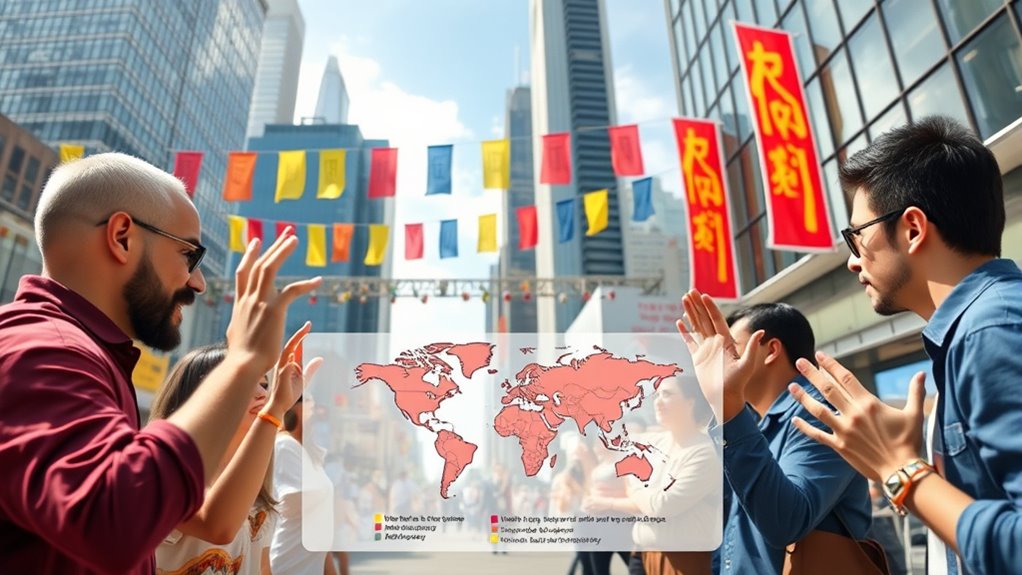By 2025, sign language policies worldwide are gaining ground through legal recognition, inclusion in education, and technological support. Governments are working to guarantee accessibility in healthcare and public services while promoting awareness campaigns to challenge stereotypes. International efforts foster cooperation and share best practices. Cultural attitudes greatly influence progress, but emerging innovations are opening new opportunities for communication. Continuing your exploration will reveal how these developments shape the future of sign language rights globally.
Key Takeaways
- Many countries are legally recognizing sign languages as official languages, promoting cultural diversity and societal inclusion by 2025.
- Integration of sign language curricula and teacher training enhances inclusive education systems worldwide.
- Advanced technologies like AI-driven translation apps and gesture recognition improve accessibility and communication for deaf communities.
- Cross-border cooperation and international treaties support resource sharing and the development of shared educational tools.
- Addressing linguistic diversity and cultural perceptions remains crucial to ensure equitable legal protections and societal support globally.
Global Recognition of Sign Languages in Legal Frameworks

Many countries are increasingly recognizing sign languages within their legal systems, acknowledging them as official languages that deserve protection and support. This move highlights the importance of linguistic diversity, showing respect for the unique ways deaf communities communicate and express their culture. By granting legal recognition, governments affirm the cultural recognition of sign languages as essential parts of national identity. This legal acknowledgment not only helps preserve these languages but also promotes equal rights for deaf individuals. When sign languages are officially recognized, it sets a foundation for better access to services, legal protections, and societal inclusion. Such measures demonstrate a commitment to respecting and valuing the rich cultural diversity that sign languages embody worldwide. Furthermore, teaching methods adapted for deaf communities can be more effectively implemented when sign languages are legally protected.
Integration of Sign Language in Educational Systems

Integrating sign language into educational systems is essential for ensuring that deaf students have equal access to quality learning opportunities. You need to see that sign language curricula are incorporated into mainstream and special education programs, making them a core part of the classroom. Equally important is exhaustive teacher training, which prepares educators to effectively teach in sign language and support deaf students. Well-trained teachers can foster inclusive environments that respect linguistic and cultural identities. Schools that prioritize sign language curricula and invest in teacher training help bridge gaps in access and participation. By doing so, you promote not only academic success but also social integration, empowering deaf students to thrive alongside their hearing peers. Additionally, integrating educational toys that support sign language learning can further enhance communication skills and engagement in the classroom.
Public Services and Accessibility for Sign Language Users

You rely on public services to meet your needs, so it’s essential they are accessible to sign language users. In healthcare and government settings, effective communication can make a real difference in your experience. Examining how these services accommodate sign language users highlights progress and areas for improvement worldwide. Implementing clear visual communication methods can further enhance understanding and inclusivity in these environments.
Sign Language in Healthcare
Access to effective communication in healthcare is essential for sign language users to receive quality medical services. Ensuring this involves implementing key strategies such as:
- Providing professional sign language interpretation services to bridge communication gaps during appointments.
- Training healthcare providers in sign language and cultural competence to improve direct communication and sensitivity.
- Developing policies that mandate the availability of interpretation services and provider training to promote equitable care.
- Incorporating automation and digital solutions to facilitate communication and record-keeping in healthcare settings.
Government Service Accessibility
Effective communication in healthcare highlights the importance of accessible government services for sign language users. You benefit when government agencies adopt technology innovation, such as real-time sign language interpretation and accessible online platforms. These tools make public services more inclusive, reducing barriers and waiting times. Community engagement plays a crucial role; involving sign language users in policy development ensures services meet actual needs. Through feedback and collaboration, governments can tailor solutions that enhance accessibility, from social services to emergency responses. By prioritizing technology and community input, you’ll find government agencies become more responsive and user-friendly for sign language users. This approach not only improves individual access but also promotes equitable participation in civic life, fostering a more inclusive society. Additionally, integrating public service hours information into accessible formats ensures that sign language users can plan their visits effectively and without unnecessary difficulty.
Government Initiatives Promoting Sign Language Awareness

Governments are taking steps to promote sign language awareness through legislation and policy frameworks. Public awareness campaigns play a vital role in educating society and reducing stigma. These initiatives help foster a more inclusive environment for sign language users. Promoting sign language recognition is essential for ensuring equal rights and accessibility for all individuals.
Legislation and Policy Frameworks
Many countries have recognized the importance of promoting sign language awareness through legislation and policy initiatives. These efforts shape the foundation for effective policy implementation and guarantee legal recognition of sign language rights. To deepen your understanding, consider these key aspects:
- Enactment of extensive sign language legislation that guarantees linguistic rights and accessibility.
- Establishment of clear policy frameworks to guide implementation across education, healthcare, and public services.
- Regular review mechanisms to update laws and policies, aligning them with evolving needs and international standards.
Public Awareness Campaigns
Building on the legal frameworks that recognize sign language rights, public awareness campaigns play a crucial role in changing perceptions and encouraging broader societal acceptance. These campaigns leverage media representation to showcase positive images of Deaf communities and highlight the importance of sign language. By using television, social media, and public service announcements, governments can reach diverse audiences and dispel misconceptions. Community engagement is vital; involving Deaf individuals in planning and sharing their stories fosters authentic understanding and empathy. Effective campaigns not only educate the public but also promote inclusivity, inspiring support for sign language rights. Additionally, incorporating private placement strategies can help fund and sustain these initiatives. Ultimately, these initiatives help normalize sign language in everyday life, paving the way for a more inclusive society that values linguistic diversity.
Challenges in Standardizing Sign Language Policies

Standardizing sign language policies proves challenging because of the vast linguistic diversity among different communities. This diversity complicates efforts toward policy harmonization, as each community’s unique language and cultural context must be considered. To navigate these challenges, you should focus on:
- Recognizing the distinct linguistic features of each sign language to respect community identities.
- Developing flexible policies that accommodate regional variations without sacrificing overall coherence.
- Engaging local stakeholders early to ensure policies align with community needs and cultural nuances.
- Incorporating knowledge of Self Watering Plant Pots to understand the importance of adaptable and context-specific solutions.
These steps help address the core issues of linguistic diversity, but they also highlight the difficulty of creating one-size-fits-all solutions. Achieving effective policy harmonization requires balancing global standards with local realities.
Emerging Technologies Supporting Sign Language Communication

Emerging technologies are transforming sign language communication by offering innovative tools that bridge gaps created by linguistic diversity. Assistive communication devices, such as real-time translation apps and sign language recognition software, enable smoother interactions between deaf communities and the wider public. Technological innovations like AI-powered avatars and gesture recognition cameras allow users to communicate more naturally and efficiently. These tools not only improve accessibility but also foster independence and inclusion. Additionally, mobile apps now provide instant translation, making it easier for sign language users to access services and participate in everyday activities. As these technologies evolve, they pave the way for more seamless, inclusive communication environments. Furthermore, integrating advanced styling techniques into sign language interpretation can enhance clarity and effectiveness during interactions. Your engagement with these tools enhances connectivity, ensuring that sign language users have greater access to information and social participation.
Collaborative Efforts and International Agreements

International collaboration plays a vital role in promoting inclusive sign language policies worldwide. By engaging in international treaties and cross-border cooperation, countries can share resources, expertise, and best practices. Such efforts help standardize sign language recognition and accessibility across borders, fostering inclusivity. To strengthen these initiatives, focus on:
- Establishing international treaties that protect sign language rights and promote their recognition globally.
- Facilitating cross-border cooperation to develop shared educational tools and resources.
- Promoting joint research projects that address common challenges in sign language policy implementation.
- Leveraging global networks for water access to support sustainable infrastructure development in deaf communities.
These collaborative efforts ensure that sign language rights are prioritized internationally, encouraging governments to work together toward more inclusive and equitable policies for deaf communities everywhere.
Impact of Cultural Attitudes on Sign Language Rights

Cultural attitudes deeply influence how societies perceive and uphold sign language rights. When cultural perceptions view sign language as less valid or secondary to spoken language, societal stereotypes often diminish its importance. This can lead to limited recognition, inadequate legal protections, and fewer resources for Deaf communities. Conversely, societies that value linguistic diversity and Deaf culture tend to promote inclusive policies and prioritize sign language rights. Your perceptions and biases shape the level of acceptance and support Deaf individuals receive. Challenging negative stereotypes and fostering positive cultural perceptions are essential for advancing sign language rights globally. Ultimately, cultural attitudes act as a foundation that either empowers or hinders progress toward equality and full recognition of sign language as a legitimate language.
Future Directions and Policy Recommendations

Building on the influence of cultural attitudes, shaping future policies requires deliberate strategies that promote recognition and protection of sign language rights worldwide. You should prioritize integrating technological innovation to enhance accessibility and learning, ensuring sign language adapts to evolving digital landscapes. Equally important is fostering community engagement, giving deaf communities a voice in policymaking and implementation. To achieve this, consider these steps:
- Develop policies that encourage technological tools for sign language education and communication.
- Establish platforms for ongoing community participation in decision-making processes.
- Promote international collaboration to share best practices and advance legal protections globally.
Frequently Asked Questions
How Do Sign Language Policies Vary Across Different Regions?
You’ll notice that sign language policies differ widely across regions due to cultural perceptions and legislative inconsistencies. Some countries embrace sign language as an official language, promoting accessibility, while others overlook it, reflecting varying societal attitudes. These differences shape the support and resources available to deaf communities. You should understand that local beliefs and inconsistent laws influence how sign language is recognized, supported, and incorporated into education and public life worldwide.
What Role Do Deaf Communities Play in Policy Development?
You see, deaf communities play a crucial role in shaping policies through deaf advocacy and active community involvement. They voice their needs, ensuring policies respect their language and culture. When deaf people participate directly, policies become more inclusive and effective. Your support for community-led initiatives helps amplify their voices, leading to better recognition of sign language rights and more equitable policies that truly serve deaf communities.
How Are Sign Languages Preserved Amid Globalization and Modernization?
Did you know that over 300 sign languages exist worldwide? You can help preserve these vibrant forms of cultural preservation and maintain linguistic diversity by supporting local deaf communities and promoting education. Modern technology, like video sharing and online resources, enables sign languages to thrive despite globalization. Your involvement preserves unique cultural expressions, ensuring that future generations continue to enjoy the rich diversity of sign languages across the globe.
What Funding Sources Support Sign Language Initiatives Worldwide?
You’ll find that funding for sign language initiatives comes from a mix of government grants, NGOs, and private donors, all aiming to improve educational access and promote technological innovations. These sources support resources like interpreter services, educational programs, and digital tools that help preserve and advance sign languages. By leveraging this funding, you can guarantee broader inclusion, better communication, and sustained cultural recognition for deaf communities worldwide.
How Is the Effectiveness of Sign Language Policies Measured?
You might think measuring sign language policy success is a tall order, but it’s doable with the right tools. You’ll look at educational integration, seeing how well sign language is incorporated into schools. Technological advancements also play a role, providing new ways to assess accessibility and communication. When these elements improve, it’s a sign that policies are working—showing real progress and making a difference for the deaf community.
Conclusion
By embracing bold policies, bridging barriers, and boosting awareness, you can help build a world where sign language is seamlessly supported and strongly celebrated. Recognizing rights, reinforcing resources, and rallying communities create a more inclusive international environment. Together, through targeted efforts and technical innovations, you can transform challenges into chances, championing change and championing champions of sign language rights. Let’s lead the way toward a truly accessible and affirming future for all sign language users.











